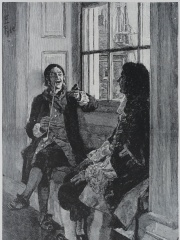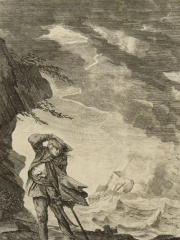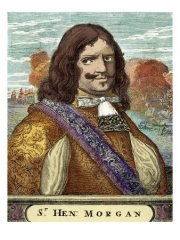

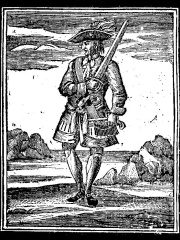
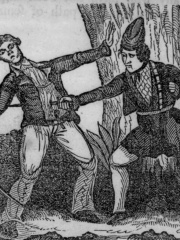
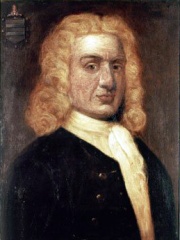
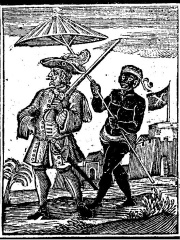
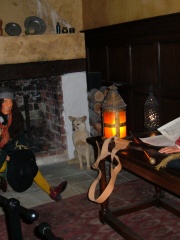
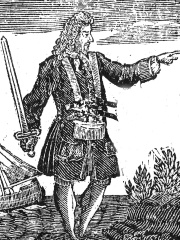
The Most Famous
PIRATES from United Kingdom
This page contains a list of the greatest British Pirates. The pantheon dataset contains 29 Pirates, 12 of which were born in United Kingdom. This makes United Kingdom the birth place of the most number of Pirates.
Top 10
The following people are considered by Pantheon to be the top 10 most legendary British Pirates of all time. This list of famous British Pirates is sorted by HPI (Historical Popularity Index), a metric that aggregates information on a biography's online popularity. Visit the rankings page to view the entire list of British Pirates.

1. Henry Morgan (1635 - 1688)
With an HPI of 79.30, Henry Morgan is the most famous British Pirate. His biography has been translated into 53 different languages on wikipedia.
Sir Henry Morgan (Welsh: Harri Morgan; c. 1635 – 25 August 1688) was a Welsh privateer, plantation owner, and, later, the lieutenant governor of Jamaica. From his base in Port Royal, Jamaica, he and those under his command raided settlements and shipping ports on the Spanish Main, becoming wealthy as they did so. With the prize money and loot from the raids, Morgan purchased three large sugar plantations on Jamaica. Much of Morgan's early life is unknown; he was born in an area of Monmouthshire that is now part of the city of Cardiff. It is not known how he made his way to the West Indies, or how the Welshman began his career as a privateer. He was probably a member of a group of raiders led by Sir Christopher Myngs in the late 1650s during the Anglo-Spanish War. Morgan became a close friend of Sir Thomas Modyford, the Governor of Jamaica; as diplomatic relations between the Kingdom of England and Spain worsened in 1667, Modyford gave Morgan a letter of marque, or a licence, to attack and seize Spanish vessels. Morgan subsequently conducted successful and highly lucrative raids on Puerto del Príncipe (now Camagüey in modern Cuba) and Porto Bello (now Portobelo in modern Panamá). In 1668, he sailed for Maracaibo, Venezuela, and Gibraltar, on Lake Maracaibo; he plundered both cities before destroying a large Spanish squadron as he escaped. In 1671, Morgan and company attacked Panama City, landing on the Caribbean coast and traversing the isthmus and its jungles before they attacked the city, located on the Pacific coast. This event occurred after the signing of a peace treaty, and, to appease the Spanish, Morgan was arrested and summoned to London in 1672; the Welshman was popularly celebrated as a hero and soon regained the favour of the government and King Charles II. Morgan was then appointed a Knight Bachelor in November 1674 and returned to the Colony of Jamaica shortly thereafter to serve as the territory's lieutenant governor. He served on the Assembly of Jamaica until 1683; on three occasions, he acted as governor in the absence of the then-current post-holder. His reputation was marred by a scurrilous memoir by Alexandre Exquemelin, a former Flemish shipmate of Morgan, accusing him of widespread torture and other offences, including during the infamous raid on Panama City. Morgan won a libel suit against the book's English publishers, but Exquemelin's portrayal has negatively shifted the public's, and history's, view of Morgan as a scoundrel. His life was further romanticised after his 1688 passing, as he became the inspiration for pirate-themed works of fiction across a range of genres.

2. Blackbeard (1680 - 1718)
With an HPI of 77.83, Blackbeard is the 2nd most famous British Pirate. His biography has been translated into 62 different languages.
Edward Teach (or Thatch; c. 1680 – 22 November 1718), better known as Blackbeard, was an English pirate who operated around the West Indies and the eastern coast of Britain's North American colonies. Little is known about his early life, but he may have been a sailor on privateering ships during Queen Anne's War before he settled on the Bahamian island of New Providence, a base for Captain Benjamin Hornigold, whose crew Teach joined around 1716. Hornigold placed him in command of a sloop that he had captured, and the two engaged in numerous acts of piracy. Their numbers were boosted by the addition to their fleet of two more ships, one of which was commanded by Stede Bonnet, but Hornigold retired from piracy toward the end of 1717, taking two vessels with him. Teach captured a French slave ship known as La Concorde, renamed her Queen Anne's Revenge, equipped her with 40 guns, and crewed her with over 300 men. His nickname derived from his thick black beard and menacing appearance. He was reported to have tied lit fuses (slow matches) under his hat to frighten his enemies. He formed an alliance of pirates and blockaded the port of Charles Town, South Carolina, ransoming its inhabitants. He then ran Queen Anne's Revenge aground on a sandbar near Beaufort, North Carolina. He parted company with Stede Bonnet and settled in Bath, North Carolina, historically known as Bath Town, where he accepted a royal pardon. However, he was soon back at sea, where he attracted the attention of Alexander Spotswood, the governor of Virginia. Spotswood arranged for a party of soldiers and sailors to capture him. On 22 November 1718, following a ferocious battle at Ocracoke, Teach and several of his crew were killed by a small force of sailors led by Lieutenant Robert Maynard. Teach was a shrewd and calculating leader who spurned the use of violence, relying instead on his fearsome image to elicit the response that he desired from those whom he robbed. He was romanticised after his death and became the inspiration for an archetypal pirate in works of fiction across many genres.

3. Calico Jack (1682 - 1720)
With an HPI of 77.56, Calico Jack is the 3rd most famous British Pirate. His biography has been translated into 43 different languages.
John Rackham (hanged 18 November 1720) was a Golden Age pirate, probably of English nationality, operating in the Bahamas and Jamaica during the early 18th century. Although only referred to as John Rackham in primary sources, he is best known today by the fictional nickname Calico Jack. Rackham was active in 1720, towards the end of the Golden Age of Piracy, and is most remembered for having two female pirate crew members: Anne Bonny and Mary Read. Rackham's life prior to piracy is unknown. The first biography of Rackham comes from Captain Charles Johnson's 1724 book A General History of the Pyrates. According to Johnson, Rackham was a pirate from England who served under Charles Vane before becoming captain. Though Johnson's version of events has become generally accepted, there is little evidence to support it. Rackham first appears in records around August 1720 after stealing merchant John Ham's sloop from Nassau harbor. After a short two-month run, Rackham was captured by Jonathan Barnet, a former English privateer, in October 1720. Rackham was put on trial by Sir Nicholas Lawes, Governor of Jamaica, and hanged on the 18th of November that year in Port Royal, Jamaica.

4. Mary Read (1695 - 1721)
With an HPI of 71.57, Mary Read is the 4th most famous British Pirate. Her biography has been translated into 44 different languages.
Mary Read (died April 1721), was an English pirate who served under John Rackham. She and Anne Bonny were among the few female pirates during the "Golden Age of Piracy". Much of Read's background is unknown. The first biography of Read comes from Captain Charles Johnson's 1724 book, A General History of the Pyrates. According to Johnson, Read was born in England, dressed as a boy much of her childhood, eventually joined the military and later moved to the West Indies. Though Johnson's version of events has become generally accepted, there is little evidence to support it. At an unknown date, Read traveled to the Bahamas where she became acquainted with the pirate John Rackham. In August 1720, Read joined Rackham's crew, alongside another female pirate, Anne Bonny. Together they stole the sloop William owned by John Ham from Nassau on 22 August 1720. Rackham and his crew carried out a number of attacks on merchant ships in the West Indies until they were captured by former privateer Jonathan Barnet following a brief naval engagement in October 1720 near Jamaica. Rackham, along with all the male crew members, were tried, sentenced, and executed, but Read and Bonny both claimed to be pregnant during their trials and received a stay of execution. While Anne Bonny’s fate is unknown, Mary Read died while imprisoned in Spanish Town around April 1721 of an unknown cause.
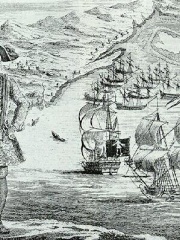
5. Bartholomew Roberts (1682 - 1722)
With an HPI of 70.05, Bartholomew Roberts is the 5th most famous British Pirate. His biography has been translated into 35 different languages.
Bartholomew Roberts (17 May 1682 – 10 February 1722), born John Roberts, was a Welsh pirate who was, measured by vessels captured, the most successful pirate of the Golden Age of Piracy. During his piratical career, he took over 400 prize ships, although most were mere fishing boats. Roberts raided ships off the Americas and the West African coast between 1719 and 1722; he is also noted for creating his own pirate code, and adopting an early variant of the Skull and Crossbones flag. Roberts' infamy and success saw him become known as The Great Pyrate and eventually as Black Bart (Welsh: Barti Ddu, though this was a later attribution and was not used in his lifetime), and made him a popular subject for writers of both fiction and non-fiction. To this day, Roberts continues to feature in popular culture, and has inspired fictional characters (such as the Dread Pirate Roberts).

6. William Kidd (1645 - 1701)
With an HPI of 69.69, William Kidd is the 6th most famous British Pirate. His biography has been translated into 41 different languages.
William Kidd (c. 1645 – 23 May 1701), also known as Captain William Kidd or simply Captain Kidd, was a Scottish privateer. Conflicting accounts exist regarding his early life, but he was likely born in Dundee and later settled in New York City. By 1690, Kidd had become a highly successful privateer, commissioned to protect English interests in the Thirteen Colonies in North America and the West Indies. In 1695, Kidd received a royal commission from the Earl of Bellomont, the governor of New York, Massachusetts Bay and New Hampshire, to hunt down pirates and enemy French ships in the Indian Ocean. He received a letter of marque and set sail on a new ship, Adventure Galley, the following year. On his voyage he failed to find many targets, lost much of his crew and faced threats of mutiny. In 1698, Kidd captured his greatest prize, the 400-ton Quedagh Merchant, a ship hired by Armenian merchants and captained by an Englishman. The political climate in England had turned against him, however, and he was denounced as a pirate. Bellomont engineered Kidd's arrest upon his return to Boston and sent him to stand trial in London. He was found guilty and hanged in 1701. Kidd was romanticised after his death and his exploits became a popular subject of pirate-themed works of fiction. The belief that he had left buried treasure contributed significantly to his legend, which inspired numerous treasure hunts in the following centuries.

7. Henry Every (1659 - 1699)
With an HPI of 69.25, Henry Every is the 7th most famous British Pirate. His biography has been translated into 33 different languages.
Henry Every, also known as Henry Avery (born 20 August 1659; disappeared June 1696), sometimes erroneously given as Jack Avery or John Avery, was an English pirate who operated in the Atlantic and Indian oceans in the mid-1690s. He probably used several aliases throughout his career, including Benjamin Bridgeman, and was known as Long Ben to his crewmen and associates. Dubbed the Arch Pirate and the King of Pirates by contemporaries, Every was infamous for being one of the very few major pirate captains to escape with his loot without being arrested or killed in battle, and for being the perpetrator of what has been called the most profitable act of piracy in history. Although Every's career as a pirate lasted only two years, his exploits captured the public's imagination, inspired others to take up piracy, and spawned works of literature. He began his pirate career while he was first mate aboard the warship Charles II. As the ship lay anchored in the northern Spanish harbour of Corunna, the crew grew discontented as Spain failed to deliver a letter of marque and Charles II's owners failed to pay their wages, so they mutinied. Charles II was renamed the Fancy and the crew elected Every its captain. Every's most famous raid was on a 25-ship convoy of Grand Mughal vessels making the annual pilgrimage to Mecca, including the treasure-laden Ghanjah dhow Ganj-i-Sawai and its escort, Fateh Muhammed. On 7 September 1695, joining forces with several pirate vessels, Every commanded the small pirate squadron. They captured up to £600,000 in precious metals and jewels (equivalent to around £115.3 million in 2023). This caused considerable damage to England's fragile relations with the Mughals. A combined bounty of £1,000—an immense sum at the time—was offered by the Privy Council and the East India Company for his capture. This is considered the first worldwide manhunt in recorded history. Although a number of his crew were subsequently arrested, Every himself eluded capture, vanishing from all records in 1696; his whereabouts and activities after this period are unknown. Unconfirmed accounts state he may have changed his name and retired, quietly living out the rest of his life in either Britain or on an unidentified tropical island, while alternative accounts consider Every may have squandered his riches. He is considered to have died sometime between 1699 and 1714; his treasure has never been recovered.

8. Benjamin Hornigold (1680 - 1719)
With an HPI of 67.09, Benjamin Hornigold is the 8th most famous British Pirate. His biography has been translated into 28 different languages.
Benjamin Hornigold (c. 1680–1719) was an English pirate towards the end of the Golden Age of Piracy. Born in England in the late 17th century, Hornigold began his pirate career in 1713, attacking merchant ships in the Bahamas. He helped to establish the "Republic of Pirates" in Nassau and by 1717 was the captain of one of the most heavily armed ships in the region, called the Ranger. It was at this time he appointed Edward Teach, best known in history books as "Blackbeard", as his second-in-command. Mindful not to attack British-led ships during his career, his crew eventually grew tired of the tactic and Hornigold was voted out as captain. In December 1718, Hornigold accepted a King's Pardon for his crimes and became a pirate hunter, pursuing his former allies on behalf of the Governor of the Bahamas, Woodes Rogers. He was killed when his ship was wrecked on a reef near New Spain during the hurricane season of 1719.

9. Charles Vane (1680 - 1721)
With an HPI of 65.32, Charles Vane is the 9th most famous British Pirate. His biography has been translated into 25 different languages.
Charles Vane (hanged 29 March 1721) was an English pirate who operated in the Bahamas during the Golden Age of Piracy. Vanes place of birth is unknown. One of his first pirate ventures was under the leadership of Henry Jennings, during Jennings' attack on the salvage camp for the wrecked Spanish 1715 Treasure Fleet off the coast of Florida. By 1717, Vane was commanding his own vessels and was a notable member of the Flying Gang in Nassau. In 1718, Vane agreed to stop his pirate activities and declared his intention to accept a King's Pardon; however, just months later he and his men, including Edward England returned to piracy. Vane was known for his cruelty, and in court documents is said to have beaten, tortured, and interrogated sailors from ships he captured. In February 1719, Vane was caught in a storm in the Bay Islands and was marooned on an uncharted island. Upon being discovered by a passing British ship, he was arrested and brought to Port Royal where he was eventually tried and hanged in March 1721.
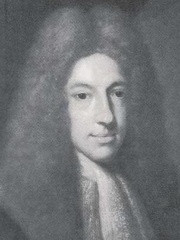
10. Samuel Bellamy (1689 - 1717)
With an HPI of 63.03, Samuel Bellamy is the 10th most famous British Pirate. His biography has been translated into 27 different languages.
Captain Samuel Bellamy (c. 23 February 1689 – 26 April 1717), erroneously known as "Black Sam" Bellamy, was an English sailor turned pirate during the early 18th century. He is best known as one of the wealthiest pirates in the Golden Age of Piracy. Though his known career as a pirate captain lasted little more than a year, he and his crew captured at least 53 ships. Posthumously called "Black Sam" in Cape Cod folklore - supposedly because he eschewed the fashionable powdered wig in favor of tying back his long black hair with a simple band - Bellamy became known for his mercy and generosity toward those he captured on his raids. This legend earned him another nickname, the "Prince of Pirates". He likened himself to Robin Hood, with his crew calling themselves "Robin Hood's Men". Bellamy was born in England in 1689, and began sailing for the British Royal Navy as a teenager. After traveling to Cape Cod around 1715, he then went south to the Florida coast in an effort to locate a sunken treasure fleet. From there he made his way to the Bahamas, sailing under Benjamin Hornigold and his second-in-command, Edward "Blackbeard" Teach. After Hornigold and Teach were voted out of command, Bellamy took a captured vessel as his own, before capturing a state-of-the-art slave trade ship, the Whydah Gally, in the early spring of 1717. Two months later, the vessel was caught in a nor'easter storm off the coast of Massachusetts and sank, taking Bellamy and most of his crew down with it. The remains of the Whydah Gally were discovered in 1984, making it the first fully authenticated Golden Age pirate ship discovered in North America.
People
Pantheon has 12 people classified as British pirates born between 1635 and 1695. Of these 12, none of them are still alive today. The most famous deceased British pirates include Henry Morgan, Blackbeard, and Calico Jack.
Deceased British Pirates
Go to all RankingsHenry Morgan
1635 - 1688
HPI: 79.30
Blackbeard
1680 - 1718
HPI: 77.83
Calico Jack
1682 - 1720
HPI: 77.56
Mary Read
1695 - 1721
HPI: 71.57
Bartholomew Roberts
1682 - 1722
HPI: 70.05
William Kidd
1645 - 1701
HPI: 69.69
Henry Every
1659 - 1699
HPI: 69.25
Benjamin Hornigold
1680 - 1719
HPI: 67.09
Charles Vane
1680 - 1721
HPI: 65.32
Samuel Bellamy
1689 - 1717
HPI: 63.03
Thomas Tew
1649 - 1695
HPI: 62.38
Edward Low
1690 - 1724
HPI: 60.94

